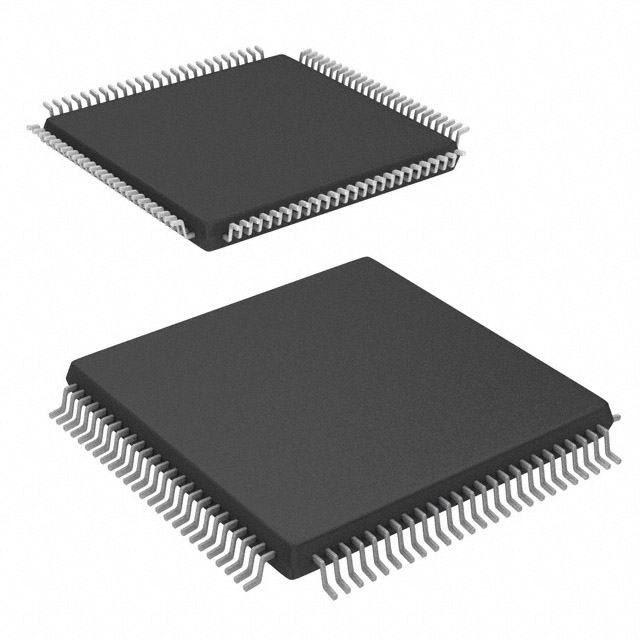Xem thông số kỹ thuật để biết chi tiết sản phẩm.

ATXMEGA128A1-AUR
Product Overview
Category
ATXMEGA128A1-AUR belongs to the category of microcontrollers.
Use
It is primarily used for embedded systems and applications that require a high-performance microcontroller.
Characteristics
- High-performance 8/16-bit AVR microcontroller
- Advanced RISC architecture
- Low power consumption
- Large program memory size
- Multiple communication interfaces
- High-speed data transfer capabilities
Package
ATXMEGA128A1-AUR is available in a compact and durable package, suitable for various electronic devices.
Essence
The essence of ATXMEGA128A1-AUR lies in its powerful processing capabilities and versatile features, making it an ideal choice for demanding applications.
Packaging/Quantity
ATXMEGA128A1-AUR is typically packaged in reels or trays, with a quantity of 250 units per reel/tray.
Specifications
- Microcontroller Architecture: AVR
- CPU Speed: Up to 32 MHz
- Flash Memory: 128 KB
- RAM: 8 KB
- EEPROM: 2 KB
- Operating Voltage: 1.6V - 3.6V
- Digital I/O Pins: 32
- Analog Input Channels: 8
- Communication Interfaces: UART, SPI, I2C
- Timers/Counters: 4
- PWM Channels: 8
- ADC Resolution: 12-bit
- Operating Temperature Range: -40°C to +85°C
Detailed Pin Configuration
The ATXMEGA128A1-AUR microcontroller has a total of 64 pins, which are assigned to various functions such as digital I/O, analog inputs, communication interfaces, timers, and more. The detailed pin configuration can be found in the product datasheet.
Functional Features
- High-performance processing capabilities
- Low power consumption modes for energy efficiency
- Advanced communication interfaces for seamless connectivity
- Flexible timers and counters for precise timing operations
- PWM channels for accurate control of analog signals
- Analog-to-Digital Converter (ADC) for precise analog measurements
Advantages and Disadvantages
Advantages
- Powerful processing capabilities
- Versatile communication interfaces
- Low power consumption
- Ample program memory size
- Precise analog measurements
Disadvantages
- Relatively higher cost compared to some other microcontrollers
- Steeper learning curve for beginners
Working Principles
ATXMEGA128A1-AUR operates based on the AVR architecture, utilizing a combination of hardware and software to execute instructions. It follows a RISC (Reduced Instruction Set Computer) design, which allows for efficient execution of instructions and optimized performance.
Detailed Application Field Plans
ATXMEGA128A1-AUR finds applications in various fields, including but not limited to: - Industrial automation - Consumer electronics - Automotive systems - Medical devices - Internet of Things (IoT) - Robotics
Alternative Models
There are several alternative models available that offer similar functionalities to ATXMEGA128A1-AUR. Some notable alternatives include: - ATmega128A - PIC32MX795F512L - STM32F407VG
These alternative models can be considered based on specific project requirements and compatibility with existing systems.
In conclusion, ATXMEGA128A1-AUR is a high-performance microcontroller with versatile features, making it suitable for a wide range of applications. Its powerful processing capabilities, low power consumption, and flexible communication interfaces make it an ideal choice for demanding embedded systems.
Liệt kê 10 câu hỏi và câu trả lời thường gặp liên quan đến ứng dụng ATXMEGA128A1-AUR trong giải pháp kỹ thuật
Sure! Here are 10 common questions and answers related to the application of ATXMEGA128A1-AUR in technical solutions:
Q1: What is the ATXMEGA128A1-AUR? A1: The ATXMEGA128A1-AUR is a microcontroller from Microchip's XMEGA family, featuring 128KB of flash memory, 8KB of SRAM, and various peripherals.
Q2: What are the key features of the ATXMEGA128A1-AUR? A2: Some key features include high-performance CPU, multiple communication interfaces (UART, SPI, I2C), analog-to-digital converters, timers/counters, and a wide operating voltage range.
Q3: What applications can the ATXMEGA128A1-AUR be used for? A3: The ATXMEGA128A1-AUR is suitable for a wide range of applications including industrial automation, consumer electronics, smart energy systems, and automotive solutions.
Q4: How can I program the ATXMEGA128A1-AUR? A4: The microcontroller can be programmed using various development tools such as Atmel Studio, MPLAB X IDE, or other compatible Integrated Development Environments (IDEs).
Q5: Can I use the ATXMEGA128A1-AUR for low-power applications? A5: Yes, the ATXMEGA128A1-AUR offers power-saving features like sleep modes, event system, and real-time clock (RTC) that make it suitable for low-power applications.
Q6: Does the ATXMEGA128A1-AUR support external memory expansion? A6: Yes, the microcontroller supports external memory expansion through its External Bus Interface (EBI), allowing you to connect additional RAM, ROM, or other memory devices.
Q7: Can I interface the ATXMEGA128A1-AUR with sensors? A7: Absolutely! The microcontroller has built-in analog-to-digital converters (ADCs) and digital I/O pins that can be used to interface with various sensors such as temperature, pressure, or motion sensors.
Q8: What communication interfaces are available on the ATXMEGA128A1-AUR? A8: The microcontroller provides UART, SPI, and I2C interfaces for serial communication with other devices or peripherals.
Q9: Is the ATXMEGA128A1-AUR suitable for real-time applications? A9: Yes, the microcontroller offers multiple timers/counters and a flexible event system, making it suitable for real-time applications that require precise timing and synchronization.
Q10: Are there any development boards available for the ATXMEGA128A1-AUR? A10: Yes, Microchip offers development boards like Xplained Pro series that support the ATXMEGA128A1-AUR, providing an easy way to prototype and evaluate your technical solutions.
Please note that these answers are general and may vary depending on specific requirements and use cases.

